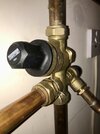A search, above for "Gledhill Lite Problems" will give lots of posts re noise problems like yours.
Its one of the worlds greatest mysteries (to me at any rate) why unvented cylinders don't have a pressure gauge.
The precharge pressure should be set to the dynamic pressure or slightly lower, 0.2/0.3 bar is recommended but I would set it to 0.5bar lower to provide more of a buffer to stop the diaphragm stopping hard up against the EV vessel water end.
Your UV/EV volumes of 250/25L with precharge/dynamic pressures of 3.0/3.0bar will give a final pressure of 3.77bar if the whole cylinder is reheated.
precharge/dynamic pressures of 2.7/3.0bar gives final pressure of 3.85bar and 2.5/3.0bar gives a final pressure of 3.91bar which shouldn't cause the slightest problem in falling to 3.0 bar.
You can read most of the advice given in the above posts, one other thing you could try is before retiring for the night is to just crack open a HW tap to give a tiny flow sufficient to prevent any pressure rise during the next (overnight?) heating time or if you know the heating time is say 30 minutes then open the HW tap to give a flow rate of say 150ml/min ( a mere trickle) as the expanded volume is only 4L after a full cylinder reheat.
Then, just before the heating session ends open the hot tap fully and see what happens.
You might post a close up photo&details of the expansion valve showing especially where the EV outlet is installed, also the expansion valve setting, it's stamped on the end.
Edit:
https://www.diynot.com/diy/threads/...-dynamic-flow-pressure-to-ev-pressure.614395/
Installing that pressure gauge would be my priority.



